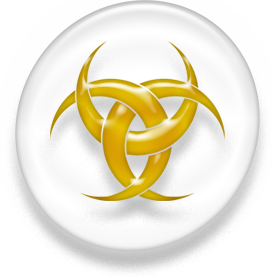Witchcraft and Voodoo are fundamentally very similar. Each is a venue for spirituality. Both reach out to the divine.
are fundamentally very similar. Each is a venue for spirituality. Both reach out to the divine.
The motivation behind both Voodoo and Witchcraft is also similar; not evil or malicious, Voodoo and Witchcraft at their core are made to help real people solve the real problems that occur in their daily lives. These are holistic spiritual practices meant to touch every aspect of a person's life; they promote spiritual development, personal enrichment, and love.
 |
| Voodoo Altar, French Quarter, New Orleans (Photo credit: Wikipedia) |
The history of Voodoo and Witchcraft also has parallels. While Voodoo is an African magical tradition, Witchcraft is primarily a European tradition. However, both Voodoo and Witchcraft have been severely repressed. Many Witches suffered torture and death at the hands of religious authorities throughout Europe and the Americas. Similarly, when Voodoo Priests were stolen from Africa as slaves and brought to the Americas, slave masters feared the power of Voodoo magics and attempted to stamp it out at every turn.
Nonetheless, Voodoo and Witchcraft have survived. This is a testament to the power and love that lives within the hearts of devout practitioners of both traditions. Despite many centuries of severe persecution, both have retained their traditional beliefs, spells, and practices. Each has emerged stronger and more powerful in this modern world. And both are still readily available at the fingertips of those who need help from the modern Witch or Voodoo Priest.
Aside from this parallel history, the thing Voodoo and Witchcraft have most obviously in common is the practice of spell casting. As both have retained ancient magical practices the mainstream world has forgotten, they are able to offer something to us in this modern world that virtually no other venue can. It is these traditions, as well as others - such as Santeria, Candomble, Obeah, Kabbalah,
Ceremonial Magic, and more - that have retained the secrets of the ancient world and the mysteries therein. The most common workings of these - spells - can take many forms.
Voodoo and Witchcraft share many elements when it comes to spell casting. Although the rituals are very different, the purpose of the rituals is what is similar. Voodoo and Witchcraft can certainly be used for high spiritual ends, but they are also very practical. People frequently visit the Witch or Voodoo Priest for love spells, spells to help out with money, and other types of workings that generally make life easier. This is one of the amazing things about both Voodoo and Witchcraft that many mainstream religions miss out on - they understand you. They are very down to earth, understand your specific problems as a human being, and can proscribe spells and rituals that will actually help them.
The choice between Voodoo and Witchcraft is largely a matter of personal taste. When you are seeking someone to help you with spells, spiritual matters, energy work, or anything else it is important to find someone you are comfortable with. Many people have an affinity for Voodoo; if Voodoo calls out to you, by all means you should find a Voodoo Priest to help you. If Witchcraft appeals more to you, you should find a Witch. As spiritual beings first and foremost we know what is best for us; listen to your heart and find the tradition that speaks to you.



